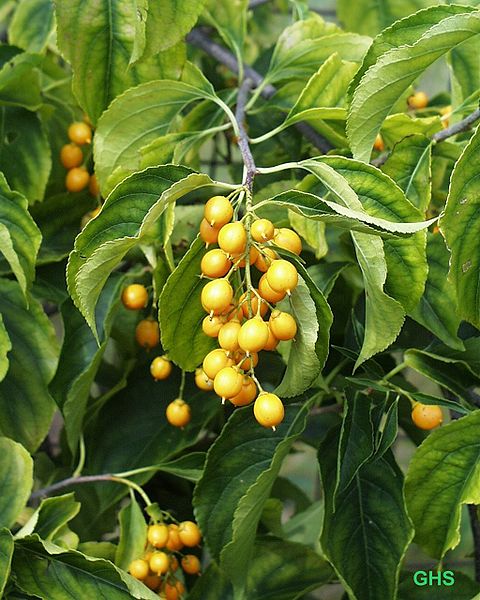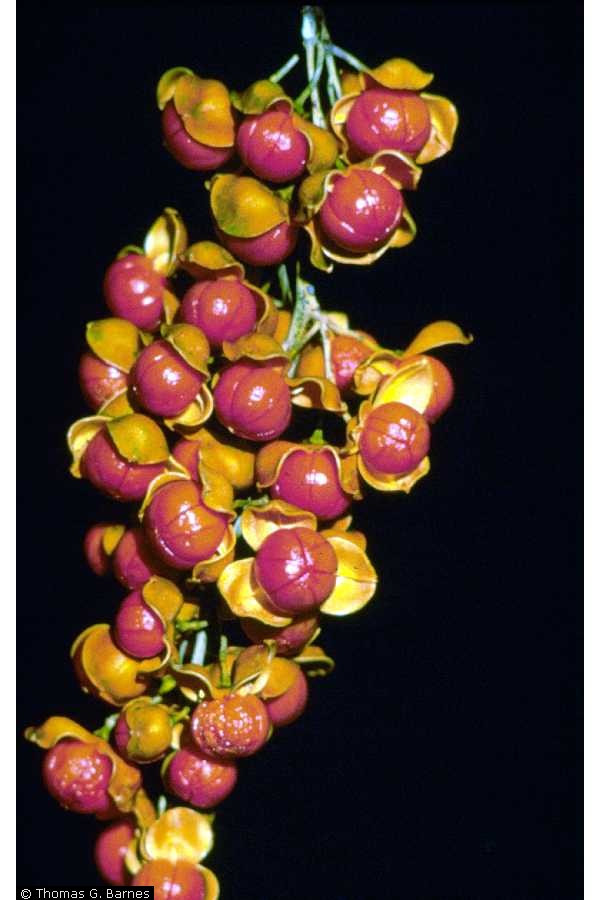 |
|
|
 |
| Thomas G. Barnes @ USDA-NRCS PLANTS Database |
Translate this page:
Summary
Bloom Color: Green, Yellow.
Main Bloom Time: Mid summer. Form: Spreading or horizontal, Variable spread.
Physical Characteristics

 Celastrus scandens is a deciduous Climber growing to 8 m (26ft 3in) at a fast rate.
Celastrus scandens is a deciduous Climber growing to 8 m (26ft 3in) at a fast rate.
See above for USDA hardiness. It is hardy to UK zone 2. It is in flower from July to August, and the seeds ripen in October. The species is dioecious (individual flowers are either male or female, but only one sex is to be found on any one plant so both male and female plants must be grown if seed is required). and is pollinated by Bees. The plant is not self-fertile.
It is noted for attracting wildlife.
Suitable for: light (sandy), medium (loamy) and heavy (clay) soils. Suitable pH: mildly acid and neutral soils. It can grow in full shade (deep woodland) semi-shade (light woodland) or no shade. It prefers moist soil.
UK Hardiness Map
US Hardiness Map
Synonyms
Plant Habitats
Woodland Garden Dappled Shade; Shady Edge; not Deep Shade;
Edible Uses
Edible Parts: Stem
Edible Uses:
Bark and twigs - they must be cooked[105]. The thickish bark is sweet and palatable after boiling[2, 161, 177]. Another report says that it is the inner bark that is used, and that it is a starvation food, only used when other foods are in short supply[257]. Some caution is advised in the use of this plant since there are suggestions of toxicity.
References More on Edible Uses
Medicinal Uses
Plants For A Future can not take any responsibility for any adverse effects from the use of plants. Always seek advice from a professional before using a plant medicinally.
Analgesic Antirheumatic Cancer Cardiac Diaphoretic Diuretic Dysentery Emetic
Skin
Climbing bittersweet was employed medicinally by a number of native North American Indian tribes, though it is scarcely used in modern herbalism[257]. The root is diaphoretic, diuretic and emetic[222]. It is a folk remedy for chronic liver and skin ailments (including skin cancer), rheumatism, leucorrhoea, dysentery and suppressed menses[222]. A strong compound infusion, usually combined with raspberry leaf tea, has been used to reduce the pain of childbirth[257]. A poultice of the boiled root has been used to treat obstinate sores, skin eruptions etc[257]. Externally, the bark is used as an ointment on burns, scrapes and skin eruptions[222]. Extracts of the bark are thought to be cardioactive[222]. Many plants in this genus contain compounds of interest for their antitumour activity[218].
References More on Medicinal Uses
The Bookshop: Edible Plant Books
Our Latest books on Perennial Plants For Food Forests and Permaculture Gardens in paperback or digital formats.

Edible Tropical Plants
Food Forest Plants for Hotter Conditions: 250+ Plants For Tropical Food Forests & Permaculture Gardens.
More

Edible Temperate Plants
Plants for Your Food Forest: 500 Plants for Temperate Food Forests & Permaculture Gardens.
More

More Books
PFAF have eight books available in paperback and digital formats. Browse the shop for more information.
Shop Now
Other Uses
References More on Other Uses
Cultivation details
Landscape Uses:Arbor. Prefers a deep loamy soil[11]. Dislikes chalky soils[108]. Succeeds in full or partial shade[188]. Requires a humus-rich soil if it is to be at its best[219]. A rampant climber, it requires ample space and is best grown into an old tree. It climbs by means of twining and also by prickles on the young stems[182]. Plants do not normally require pruning[219]. The foliage of some wild plants is variegated[235]. There are some named forms, selected for their ornamental value[200]. A good bee plant[108]. Plants in this genus are notably resistant to honey fungus[200]. Plants are usually dioecious, in which case male and female plants must be grown if seed is required[182]. This species seldom fruits freely in Britain[182]. Special Features:
Attracts birds, North American native, Invasive, Attracts butterflies, Suitable for dried flowers, Inconspicuous flowers or blooms.
References Carbon Farming Information and Carbon Sequestration Information
Temperature Converter
Type a value in the Celsius field to convert the value to Fahrenheit:
Fahrenheit:
The PFAF Bookshop
Plants For A Future have a number of books available in paperback and digital form. Book titles include Edible Plants, Edible Perennials, Edible Trees,Edible Shrubs, Woodland Gardening, and Temperate Food Forest Plants. Our new book is Food Forest Plants For Hotter Conditions (Tropical and Sub-Tropical).
Shop Now
Plant Propagation
Seed - gather when ripe, store in dry sand and sow February in a warm greenhouse[78]. Three months cold stratification leads to a higher germination rate[113]. Remove the flesh of the fruit since this inhibits germination[113]. Germination rates are usually good[78]. When they are large enough to handle, prick the seedlings out into individual pots and grow them on in a greenhouse for at least their first winter. Plant them out into their permanent positions in late spring or early summer, after the last expected frosts. Layering in August of the current seasons growth. Takes 12 months[78]. Root cuttings, 6mm thick 25mm long in December. Plant horizontally in pots in a frame[78].
Other Names
If available other names are mentioned here
Native Range
NORTHERN AMERICA: Canada (Ontario, Québec (south), Manitoba (south), Saskatchewan (southeast)), United States (Connecticut, Indiana, Maine, Massachusetts, Michigan, New Hampshire, New Jersey, New York, Ohio, Pennsylvania, Rhode Island, Vermont, Illinois, Iowa, Kansas, Minnesota, Missouri, Nebraska, North Dakota, Oklahoma, South Dakota, Wisconsin, Montana (east), Wyoming (east), Alabama (north), Arkansas, Delaware, Georgia (north), Kentucky, Maryland, Mississippi (north), North Carolina (west), South Carolina, Tennessee, Texas)
Weed Potential
Right plant wrong place. We are currently updating this section.
Please note that a plant may be invasive in one area but may not in your area so it's worth checking.
Conservation Status
IUCN Red List of Threatened Plants Status :

Growth: S = slow M = medium F = fast. Soil: L = light (sandy) M = medium H = heavy (clay). pH: A = acid N = neutral B = basic (alkaline). Shade: F = full shade S = semi-shade N = no shade. Moisture: D = dry M = Moist We = wet Wa = water.
Now available:
Food Forest Plants for Mediterranean Conditions
350+ Perennial Plants For Mediterranean and Drier Food Forests and Permaculture Gardens.
[Paperback and eBook]
This is the third in Plants For A Future's series of plant guides for food forests tailored to
specific climate zones. Following volumes on temperate and tropical ecosystems, this book focuses
on species suited to Mediterranean conditions—regions with hot, dry summers and cool, wet winters,
often facing the added challenge of climate change.
Read More
Expert comment
Author
L.
Botanical References
43200
Links / References
For a list of references used on this page please go here
Readers comment